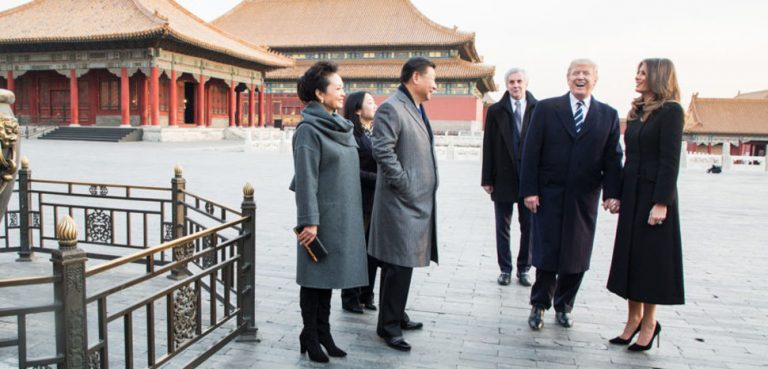The trade war with China has entered a precarious phase. What might the ramifications be of a full-blown trade war, and what is the likelihood presidents Trump and Xi manage to sign an agreement to avoid them?
Let’s establish at the outset that despite several hurdles, the balance of risks favors an agreement. The U.S. and China are the world’s two largest economies and each other’s largest trading partners. The economic costs of a complete breakdown are too great for either side to bear, while the benefits of continued trade and integration are too great to forego.
Trump’s political incentives also favor a deal. Important swing states needed to win re-election have suffered steep agricultural losses due to China’s retaliatory tariffs – China is the fourth largest agricultural export market for the U.S. What’s more, although Trump has said China has paid the U.S. billions of dollars in tariffs, U.S. consumers and importers have been paying higher Chinese import prices. If rising import costs become pervasive and tangible to U.S. consumers, and the highly touted stock market ascent reverses course, Trump’s election prospects will dwindle. Admittedly, Trump has espoused mercantilist, anti-free trade rhetoric since the 1980s, but unless Trump negotiates himself into a corner, he will sign an agreement.
For China, its vast economic interdependence with the U.S. – the U.S. consumes roughly 20% of Chinese exports – along with its $380 billion trade surplus with America, suggests China will make a deal. Its leadership is keenly aware that continued economic and income growth helps it subdue political unrest and justifies its rule. What’s more, the Chinese economy would suffer more than the U.S. from a prolonged trade war because exports comprise a larger share of its overall economic activity. China also wants to spur development in its vast hinterland since it lags the coast. Therefore, as long as the U.S. administration limits negotiations to narrowly defined trade issues, China will agree.
Economic costs
The economic costs of a full-blown trade war would be high because a confrontation between the world’s two largest economies would leave few unscathed. According to the IMF, current and proposed tariffs could cut global economic output by 0.5% in 2020. Although major central banks could cut rates or take other expansionary measures to soften the trade war’s drag, they would not fully cushion the blow.
The primary damage would be felt in the global supply chain, which has become increasingly interconnected. The impact would be global, but Asia would suffer the most since it’s become highly integrated with China’s manufacturing operations.
The concomitant regional financial shock would quickly infect others. For example, when trade negotiations reached a similar impasse in March 2018, stock prices fell and market volatility rose as investors feared an imminent full-blown trade war. More recently, when U.S.-China trade negotiations broke down on May 23rd, reigniting trade war escalation fears, major indexes in China, Germany and France fell, the S&P 500 lost 1.2%, and American crude oil prices declined more than 5% percent. The yield on the 10-year Treasury note fell to its lowest year-to-date level at 2.29%. A complete breakdown in negotiations would trigger far worse.
How might the U.S. and China fare under the trade war scenario? According to the IMF, 25% tariffs on all traded goods between the U.S. and China would lower U.S. GDP by 0.3% – 0.6% and China’s GDP by 0.5% – 1.5%. In the U.S., important U.S. tech firms, including Apple, Nvidia, and Intel, and several other industries, find themselves forced to either find new suppliers in lower-cost nations in Asia and the Americas or accept slimmer profit margins.
Southeast Asia has been the primary beneficiary of this realignment. In the first four months of the year, U.S. imports rose 38% from Vietnam, 22% from Taiwan, 17% from South Korea, and 13% from Bangladesh.
Energy industry experts believe a trade war with China could raise costs for U.S. energy consumers and threaten the current American energy boom. The energy industry has already seen its import prices rise on more than 100 Chinese products. Furthermore, crude exports to China could fall further if the trade war worsens. From October 2017 to June 2018, before the first imposition of U.S. tariffs, China received 22% of total U.S. crude oil exports and 4% of total U.S. refined products exports. After tariffs were imposed, those figures dropped to 3% and 2%, respectively, according to the American Petroleum Institute.
To date, however, the car industry appears to have been most affected; the three major auto makers warned that changes to trade policies were damaging sales.
China has suffered too. Car sales have reportedly declined due to falling consumer confidence, and the manufacturing, real estate, e-commerce, and electronics sectors have all reported weaker demand. According to UBS, Chinese growth over the next 12 months could fall by two percentage points if the U.S. put tariffs on 25% on all Chinese imports.
Leverage
Each country has leverage over the other. For instance, China could weaponize its rare earth mineral advantage. China’s large holdings of U.S. Treasury bonds, however, deserves special attention.
According to the most recent U.S. Treasury International Capital (TIC) report, China’s $1.1 trillion holdings of U.S. Treasury bonds make it the largest owner of U.S. debt. If China dumped its Treasuries, economic textbooks say rising U.S. interest rates would cause a recession.
Fortunately, U.S. Treasuries defy economic theory for several reasons. First, the dollar’s unique role as the world’s reserve currency means that central banks are not profit-motivated dollar buyers. In other words, they buy and sell the dollar to manage their currency’s value. Therefore, if China’s selling weakened the dollar, foreign currencies (including China’s) would appreciate and crimp other nations’ exports (including China’s). Foreign central banks would buy dollars, regardless of its falling value, to depreciate their currencies. Furthermore, the U.S. Federal Reserve is shrinking its balance sheet, winding down its previous quantitative easing efforts, by allowing $15 billion of U.S. Treasuries to mature each month. If necessary, the Fed could roll over the maturing debt by buying new issues.
The U.S. Treasury market’s unrivalled depth and breadth also insulates the dollar. China would be unable to move its significant dollar reserves into other currencies because no other bond market offers the U.S. market’s liquidity. German bunds are in short supply and other bond markets have more risk. Other nations, resenting large yuan inflows that sent their currencies and deflation risks higher, could respond with tariffs on Chinese goods. For these reasons and others, China will keep this weapon holstered.
Hurdles
Interestingly, the biggest hurdle negotiators must overcome is geopolitical rather than economic. The current economic confrontation is part of official Washington’s larger reassessment of its relations with China. Over the past 30 years, China has become a strategic rival to the U.S., challenging the U.S. both economically, militarily, and diplomatically. This has defied expectations; when the Washington establishment and business community supported China’s entry into the liberal, free-trade economic order, it assumed China would moderate its authoritarian tendencies and partner with the U.S. as a “responsible stakeholder.”
This has not happened. China has become more assertive in geopolitical and military affairs. China has also tried to circumscribe western multilateral organizations by creating rival ones, such as the Asian Infrastructure Investment Bank, and to increase its international economic influence via its Belt and Road Initiative. It also seeks to establish dominance in ten high-tech fields through its “Made in China 2025” plan.
U.S. domestic support for confronting China has risen. On the economic front, the American business community has grown impatient with China’s intellectual property theft, patent and copyright violations, forced technology transfers, Chinese government protection for Chinese firms, and corporate espionage. As a result, although some question the Trump administration’s go-it-alone tactics and frequent tariff levies, the confrontational strategy has rare bipartisan support.
China, meanwhile, is motivated to stand up to perceived American bullying. Some in the Communist Party leadership consider U.S. resentment at China’s rise as sour grapes of a waning superpower. China doesn’t comprehend American alarm at its Belt and Road Initiative when America is turning inward and reluctant to invest abroad. They also see the current trade war as a thinly veiled effort to contain China’s inexorable rise. Memories of the 19th century’s opium wars and the “century of humiliation” that followed remain surprisingly ripe, so China’s leaders cannot appear weak to their domestic audience. Some in China’s leadership also want China to pursue economic self-reliance.
Furthermore, Xi’s more aggressive geopolitical tactics are a paradigm shift from China’s previous method of using quiet patience to achieve its long-term goals. This tactical change makes it harder for Xi to back down, so if Trump asks for serious concessions on geopolitical issues, Xi would not comply.
Outlook
Despite these hurdles and others, a deal remains likely because failure would inflict significant economic costs. Diplomacy is the art of spinning reality into one’s preferred narrative, at which Trump is particularly adept. Statecraft is also about “splitting the difference.” Trump can strike a deal and claim a “tremendous” victory; his affinity for bombastic threats, followed by reversals due to claimed success, offers hope.
The views expressed in this article are those of the author alone and do not necessarily reflect Geopoliticalmonitor.com or any institutions with which the author is associated.




